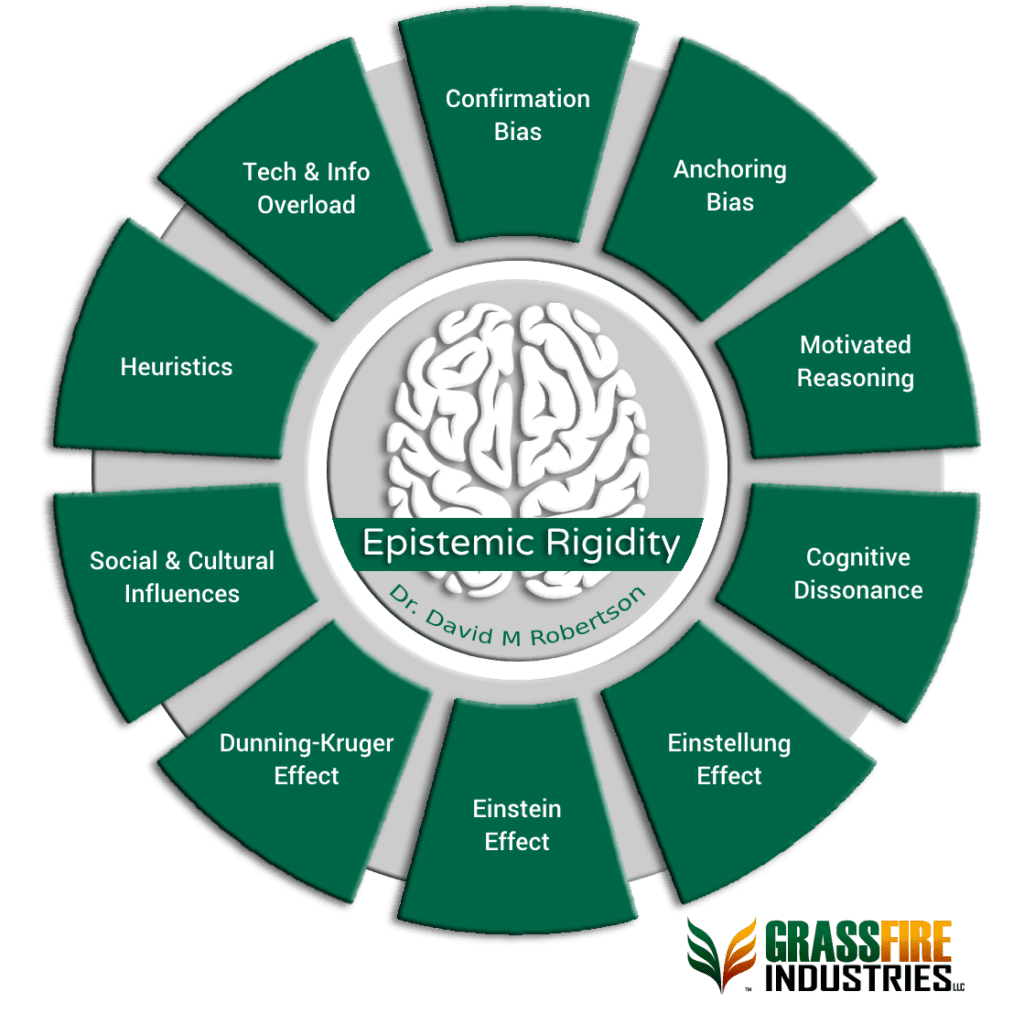Epistemic Rigidity is a theoretical framework that explains why individuals and groups struggle to update their knowledge and discard outdated information. This framework integrates various cognitive biases, including the Einstellung effect, the Einstein effect, the Dunning-Kruger effect, and anchoring bias. Additionally, it encompasses factors like confirmation bias, motivated reasoning, cognitive dissonance, and heuristics. These biases and factors create a mental and social environment where outdated knowledge persists, hindering innovation and effective decision-making.

Epistemic Rigidity in Leadership and Followership
In leadership settings, Epistemic Rigidity can manifest in several ways:
Inflexibility in Decision-Making: Leaders may rely on established practices and resist new approaches, even when presented with compelling evidence for change. This can lead to stagnation and missed opportunities for improvement. For example, a company might continue using outdated marketing strategies despite clear data showing a shift in consumer behavior.
Overconfidence in Expertise: Leaders, especially those with significant experience, may overestimate their knowledge and dismiss new information or perspectives from their team. However, this typically stifles innovation and discourages open communication. For example, an experienced manager might ignore junior employees’ suggestions, believing their own expertise is sufficient.
Anchoring on Initial Information: Initial instructions, education, strategies, or plans can become cognitive anchors, making it difficult for leaders and followers to adapt to new data or changing circumstances. For instance, a project leader might stick to an initial project plan despite new evidence indicating a need for change. Of course, this typically results in less-than-ideal outcomes.
Confirmation Bias: Both leaders and followers may seek information that supports their existing beliefs and ignore evidence that contradicts them. Unfortunately, this only reinforces existing practices and beliefs, even when they are outdated or ineffective. An example here might be an executive who only considers sales reports that show positive growth, ignoring reports that allude to emerging issues.
Motivated Reasoning and Cognitive Dissonance: Leaders and followers may rationalize or dismiss new information that conflicts with their current understanding or organizational norms to avoid the discomfort of cognitive dissonance. However, this avoidance doesn’t make the threat of accuracy any less real. An example here might be how a team might downplay the significance of a competitor’s innovative product to avoid acknowledging their own need for improvement.
Overcoming Epistemic Rigidity
To overcome Epistemic Rigidity, leaders should adopt the following strategies:
Promote a Culture of Continuous Learning: Encourage ongoing education and professional development for both leaders and followers. Training and education should be a continuous and cultural norm. This helps keep everyone updated with the latest knowledge and practices. For example, companies can offer regular training sessions, access to online courses, and leadership development.
Encourage Critical Thinking: Foster an environment where questioning and critical analysis are valued. Leaders should model this behavior by openly questioning their assumptions and inviting diverse perspectives. Hosting regular brainstorming sessions and workshops can help cultivate this culture.
Embrace Intellectual Humility: Acknowledge the limitations of one’s knowledge and remain open to new information. Leaders should demonstrate this humility to their teams, showing that it is acceptable to change one’s mind in light of new evidence. Sharing personal experiences of learning and growth can reinforce this mindset.
Utilize Diverse Information Sources: Encourage the use of a wide range of information sources to counteract the effects of cognitive biases. This includes consulting with experts from different fields and incorporating interdisciplinary approaches. For instance, bringing in external consultants can provide fresh perspectives.
Reflective Practice: Implement regular reflection sessions where leaders and teams can discuss what they have learned, what has changed, and how they can improve. This practice helps identify and correct outdated knowledge and practices. Setting aside time for team debriefs after projects can facilitate this.
Feedback Mechanisms: Establish robust feedback mechanisms that allow team members to share their insights and observations without fear of retribution. Leaders should actively seek and act on this feedback to improve decision-making processes. Anonymous surveys and suggestion boxes can be effective tools.
Benefits of Overcoming Epistemic Rigidity
Addressing Epistemic Rigidity can lead to several significant benefits:
- Enhanced Innovation: By being open to new ideas and approaches, organizations can stay ahead of the competition and adapt to changing markets.
- Improved Decision-Making: Access to diverse perspectives and updated information enables better strategic decisions.
- Increased Employee Engagement: An environment that values continuous learning and critical thinking fosters higher employee morale and retention.
- Organizational Agility: Companies become more responsive to external changes, ensuring long-term sustainability and success.
By recognizing and addressing Epistemic Rigidity, leaders can create more adaptive, innovative, and effective organizations. This approach not only enhances individual and team performance but also ensures that the organization remains competitive in a rapidly changing environment. And finally, we must never forget that information provides us with context, which enables informed experience. This combination of context and experience fosters expertise. Expertise, in turn, reveals the flaws in the initial context, ultimately enhancing and refining our knowledge and information – if we let it.

